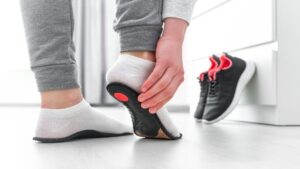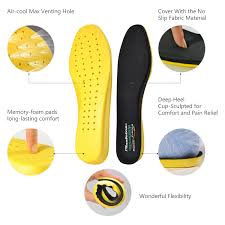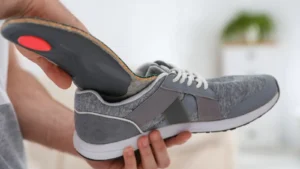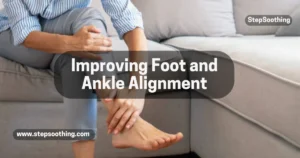Memory foam insoles offer unmatched comfort, support, and pressure relief for those seeking a solution to foot pain and discomfort. Developed with high-density polyurethane and inspired by NASA technology, these insoles provide a custom fit, absorbing impact while promoting foot health. Perfect for daily wear, they enhance efficiency and reduce fatigue.
Why Memory Foam Insoles Are the Ultimate Solution for Foot Support
Memory foam insoles offer the ultimate foot support by molding to the foot’s shape, providing personalized comfort and reducing pressure. With superior shock absorption and essential arch support, they improve posture, ease foot pain, and prevent fatigue, making them ideal for daily wear and physical activities. Perfect for various footwear styles. Advantages of Memory Foam Insoles morefully discuss below.
Comfort and Pressure Relief

Memory foam insoles are an excellent option for individuals seeking enhanced comfort and pressure relief in their shoes. Constructed from high-density polyurethane, the same material commonly used in sofas and mattresses, these insoles are renowned for providing exceptional support and cushioning.
The memory foam molds to the shape of the feet, creating a custom fit that effectively alleviates foot pain and ensures the even distribution of weight. This feature makes activities such as walking, standing, and running much more comfortable, regardless of whether the wearer is using casual or athletic footwear.
Many people have reported significant improvements after switching to memory foam insoles, especially in activities like hiking or long walks. The extra cushioning offered by the foam reduces strain on the heel and arch areas, allowing for longer durations of comfort and reduced fatigue.
Energy Return and Bounce

A standout feature of memory foam insoles is their ability to provide bounce and energy return. Originally developed using NASA technology, these insoles can absorb the pressure from each step and release it, giving the wearer an additional lift. This feature not only enhances comfort but also improves the efficiency of movement, whether it’s walking, running, or standing for extended periods.
The viscoelastic properties of memory foam allow it to compress and bounce back, ensuring that every step feels light and energized. This is particularly beneficial for athletes or anyone who spends a significant amount of time on their feet, as it helps reduce fatigue.
Foot Health Benefits

Memory foam insoles are particularly advantageous for individuals suffering from foot-related conditions such as plantar fasciitis, heel spurs, or neuromas. These insoles are specifically designed to offer superior pressure relief, especially in critical areas like the arch and heel. This makes them an excellent choice for reducing foot pain and discomfort.
People with plantar fasciitis have frequently found relief through the use of memory foam insoles, as the material adapts to the foot’s contours, easing the pressure on sensitive areas. The insoles support the natural foot structure and help alleviate pain.
Durability and Longevity

Memory foam insoles are known for their durability. Unlike traditional insoles, which tend to lose shape or flatten over time, memory foam retains its structure and remains supportive even after prolonged use. The resilient nature of the material allows it to compress and bounce back repeatedly without diminishing its supportive qualities.
Individuals who use memory foam insoles daily often notice that the insoles maintain their effectiveness for long periods, whether used in work shoes, athletic footwear, or casual wear.
Temperature Regulation and Breathability

Another significant benefit of memory foam insoles is their ability to regulate temperature. The foam responds to body heat, softening when it’s warm and staying firmer in colder conditions. This ensures that feet remain comfortable in a variety of environments. Additionally, many memory foam insoles come with breathable properties that promote air circulation, preventing sweat and overheating.
Many users have found that memory foam insoles keep their feet warm in cold weather and prevent excessive sweating in hot conditions, ensuring comfort throughout the day.
Versatility Across Footwear Types

One of the most convenient features of memory foam insoles is their versatility. These insoles can be used in a wide variety of footwear, ranging from athletic shoes to casual and formal styles. Some shoes come with removable memory foam insoles, allowing wearers to switch them out for new ones, while others enable the addition of these insoles for extra cushioning and support.
Whether it’s a pair of running shoes, dress shoes, or everyday sneakers, memory foam insoles fit comfortably across different types of footwear, providing consistent comfort and support.
Support for Extended Periods of Standing

For individuals who spend long hours on their feet, whether at work or during activities like hiking, memory foam insoles can significantly reduce pain and discomfort. The cushioning helps to alleviate the pressure on the feet, making standing for extended periods much more tolerable. Workers in physically demanding roles, in particular, often report less fatigue and foot pain after switching to memory foam insoles.
Memory foam insoles provide an ideal solution for reducing the strain associated with prolonged standing, helping individuals feel more comfortable and recover more quickly from their activities.
Safety and Protection

In environments with potential safety hazards, such as workplaces with heavy machinery or hard surfaces, memory foam insoles offer crucial protection. These insoles absorb shocks from impact and distribute pressure evenly, helping to reduce the strain on the wearer’s feet and joints. This feature makes them especially valuable in safety shoes or for anyone working in physically demanding roles.
Many users working in challenging environments have found that memory foam insoles offer not only extra cushioning but also help absorb the impact from hard surfaces, reducing the risk of long-term damage to the feet and lower limbs.
Final Thought
Memory foam insoles provide unmatched comfort and shock absorption, making them the ultimate solution for foot support. With high-density polyurethane, inspired by NASA technology, these insoles mold to your foot’s shape, providing a custom fit and pressure relief. Ideal for various footwear, they improve foot health, reduce fatigue, and support individuals who stand or walk for long periods.
People Also Ask
What are memory foam insoles made of?
Memory foam insoles are primarily made from high-density polyurethane with viscoelastic properties, allowing the foam to adapt to the foot’s shape and provide personalized comfort.
Do memory foam insoles help with foot pain?
Yes, memory foam insoles are particularly effective in reducing foot pain associated with conditions such as plantar fasciitis, heel spurs, and neuromas, offering superior cushioning and support.
Are memory foam insoles durable?
Yes, memory foam insoles are well-known for their durability. They retain their shape and supportive properties even after long periods of use, unlike traditional insoles that tend to wear out.
Can memory foam insoles be used in all types of shoes?
Absolutely. Memory foam insoles are highly versatile and can be used in a wide range of footwear, including athletic, casual, and formal shoes. Some shoes also offer removable memory foam insoles for added convenience.
How do memory foam insoles manage temperature?
Memory foam insoles are sensitive to temperature and adjust according to body heat, becoming softer in warmer environments and providing insulation in colder conditions.
Are memory foam insoles suitable for standing long periods?
Yes, memory foam insoles are ideal for people who stand for long periods, offering superior cushioning and pressure relief, which helps alleviate discomfort and reduce fatigue.
Can memory foam insoles help with odor and sweat?
Yes, many memory foam insoles come with anti-odour and anti-bacterial features, reducing the buildup of sweat and minimizing the risk of fungal infections.



